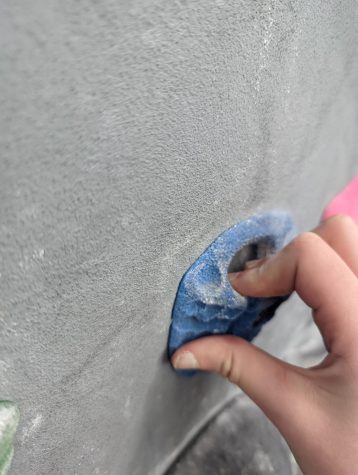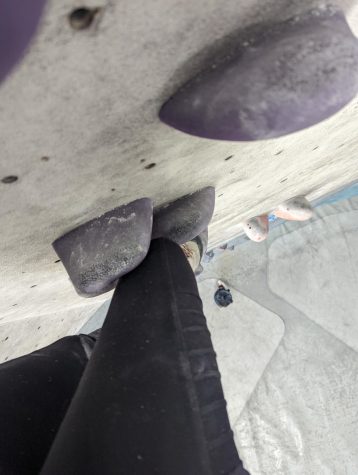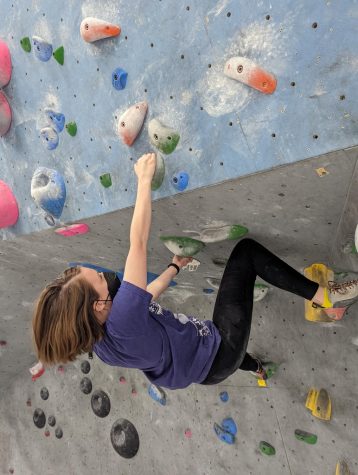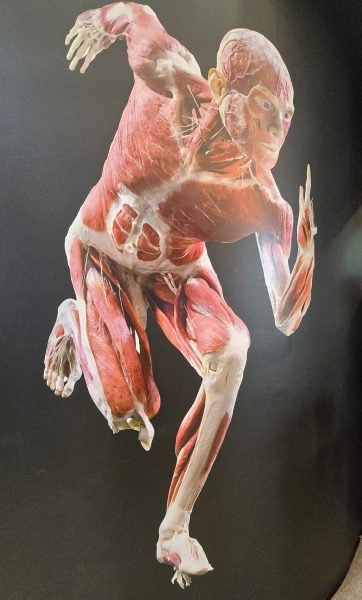Bouldering: an exciting alternative to exercise
Exercise is, let’s be honest, not particularly appealing. A treadmill is the exact same every step. Machines in a gym can be intimidating to the uninitiated, and most workouts are just several sets of the exact same thing, day in and day out.
That’s not true for rock climbing.
The Olympics. Free Solo. The Dawn Wall. Although rock climbing has been around in a form pretty similar to its modern style since the 1800s, modern media has resulted in an estimated five million regular climbers in North America today. Pushed from a sideline sport to a gold medal nail-biter at the 2020 Tokyo Olympics, nearly everyone has at least heard of rock climbing.
In the Houston area, there are three major climbing gyms: Texas Rock Gym and Momentum Katy are both traditional climbing gyms with a variety of disciplines, while Momentum Silver Street (located a ten minute drive from Carnegie) is a bouldering gym.
In all forms of climbing, bouldering is considered the easiest to join as a beginner. While other styles require a myriad of gear and training before you can begin to climb, it’s pretty simple to try bouldering. At Silver Street, you rent a pair of shoes (or bring your own), watch a five-minute safety video, and hop on the wall.
Unlike most forms of traditional exercise, climbing is ever-changing. Treadmills and dumbbells are the same every time. Most climbing gyms, including Silver Street, have new ‘problems’ (routes to be climbed) weekly. Each of those problems requires a unique approach to reach the top.
Although the difficulty of those problems range, there are always some that are beginner-friendly. At the most basic level, there’s not a lot of strength required to begin bouldering. If you can climb a ladder, there will be a route in the gym that you can conquer.

Strength definitely builds up as you continue climbing, however. The first time I tried to boulder, my fingers and forearms were dead after less than two hours from clinging to tiny bits of rock that somehow made up a problem. My entire body complained for days. (Climbing will introduce you to muscles you didn’t know you had.) But I went back, and felt so much more powerful with every trip up the wall.

There is a certain amount of adrenaline that kicks in when you step on a bouldering wall. On most climbs, there’s less than an inch of rubber and plastic between you and a fall. I don’t consider myself afraid of heights, but there were times my mind would get the best of me and I would drop down instead of risking a fall. Other times, I just had to take a moment and breathe before jumping for the next move.

The more difficult the climb, the more difficult the mind games. The first thing a climber has to master is the strength to complete a problem. Next is the mental fortitude to keep calm even when dangling from a few fingers fifteen feet in the air. Finally is the most interesting part (in my opinion): understanding the problem itself.
Climbs are rated in the V-scale, a grading system that vaguely categorizes the difficulty of a problem. Most beginners climb between VB, a rating meaning the climb is functionally a ladder, and V2, where climbs present more of a technical challenge. The main factor contributing to a V-scale rating is the level of technical skill necessary for the problem.

There were certainly problems that required technical skill.

Most of my trips to a bouldering gym last around an hour and a half. I start with a simple warm-up, a V0 or V1 that I’ve completed before, and I take it slow. I wedge my toes onto the smallest parts of the footholds. I shift my hips close to the wall so I can reach past three or four holds to one just out of reach. I slide through moves to the slow pressure of the echoing gym. The world is mine. I am strong, precise, and graceful. That first climb is meditative. It’s a chance for my body to remember how to move. It’s peaceful. A certain headspace settles like a comforting blanket on a cold and rainy day.
Next, I climb a few problems that are around the highest rating I can consistently complete. I can usually finish them on the first or second try, but this is where my heart rate gets up. Speed is almost as important as precision for this section of the trip. I have to think fast. I have to move fast. Do I pull from the right or the left? Can I jump for the next sandpaper-rough bulge in the wall, or do I need to tuck my knees up to my chest and push directly down so I don’t slip off that credit-card thin foothold? Foot bouncing against the sheer wall, fingers locking into a tiny space for a moment only–the climb passes in a blur. A one-two tap on the finish hold, and I drop back to the thick gray mat below, already scouting my next climb.

The next climb, however, is much different. I choose something difficult, either a grade or two above what I know I can do or a style that I’m not comfortable with. I lay on the mats below the climb and look.
The bright green holds are dull with white chalk and black rubber. At first glance, there’s no way to move from one to another. This climb is impossible. Only an Olympic climber would be able to solve this.
Only an Olympic climber, or me. I categorize the holds in my mind. The first hand is low, but the second is high, so I need to jump up and brace my hand against the bottom of the ledge, fingers latching onto the green tucked underneath. And then can I step where my other foot is…?
My foot slips and it’s only sheer force of will that keeps me from slamming my teeth into the plastic underneath my lower hand. Nope, that’s not right.
This time, I step where my lower hand was and I can stand up. The angle is weird on the wall, like a pendulum frozen away from center, and there’s nothing I can do but jump back down and stare at the jaunty green holds. If I didn’t know better, I’d say they were mocking me. Maybe if I…?
But my next idea doesn’t work, and neither does the next one. My fingers pop. This climb might just not be possible today. Maybe I should just cool down and go home. I might be able to get it next time.
No. I can do this.
On the next climb, I move even slower. I grip the hold on the bottom of the ledge with both hands and pull my body through the impossible pendulum. I’m moving through molasses, but soon I’m close enough to latch onto the next hold. Okay, now I’m upright. It’s a simple enough climb up. Except the hold I reach for is just slightly too far. My ankles wobble as my toes try to propel me upwards and I’m crashing back to the mats.
I’m starting to hate the color green.
But another try and a little hop lets my first finger catch the tiny bit of green above me. I can’t even see it, hidden by the other side of the ledge. For a moment, I’m dangling from that one finger with only a toe taking weight off my hand, and then I curl my middle finger around and I’ve got it. I haul myself upwards, and upwards, and over the edge. Victory rings in my aching first finger.
I finish a trip with a cool down. My fingers tremble. My forearms burn. My back aches in a way that warns me I’ll wince every time I sling my backpack over my shoulder the next day. But I work my way through one last V0, sloppily swinging up while my feet slip off footholds larger than my fists. Sometimes I complete it, and sometimes I tumble back to the mats and laugh at the ceiling, completely exhausted.
I’ve always struggled with exercising because of the boring and repetitive nature of a traditional gym. But climbing is neither boring nor repetitive! Besides the ever-shifting nature of the gym, the climbs themselves require thinking before even beginning a climb. The number of times I approached a problem only to slip back to the ground because I misread the first move was, quite frankly, embarrassing. Climbing forced me to think–not only think, but think under pressure.

If you’re unafraid of heights, or at least willing to face your fears, bouldering is a great, creative form of exercise for anyone hoping for a little more from a workout.
Your donation will support the student journalists of Carnegie Vanguard High School. Your contribution will allow us to cover our annual website hosting costs and fund field trips, competition fees, and equipment. We appreciate your support!

Hi! My name is Brooke J Ferrell. I'm a senior who, if not writing, is usually rock climbing :)











MyTran Vo • Feb 18, 2022 at 2:12 pm
Go Brooke Go!
Noah Mohamed • Feb 18, 2022 at 2:12 pm
I really like the number of pictures you used in this article! The way you describe the specific experience of being on the wall also paints a really good picture of what it feels like to climb.
Jessica Lin • Feb 18, 2022 at 2:06 pm
You were very informational and explained bouldering well to those who are unfamiliar. I’ve definitely noticed an increase in the number of Carnegie students who boulder. I also love your personal perspective.
Abigail Nunez • Feb 18, 2022 at 1:58 pm
I like how you really went into detail to express how you fight to get better at rock climbing and give us a closer look as to what is happening in your head as you are going through the motions.